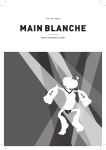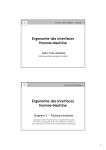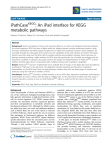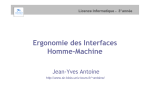Download Software Requirements Specification / User Guide
Transcript
2013 Project Team 11 Qichao Hua Ethan Johanson Steve King MengTIng Yang Yujie Zeng Software Requirements Specification / User Guide Version 1.12 July 28, 2013 PhyloDex Contents Revision history ............................................................................................................................... 2 1. Introduction ............................................................................................................................. 3 1.1. Purpose ............................................................................................................................. 3 1.2. Scope ................................................................................................................................ 3 1.3. Overview........................................................................................................................... 3 2. Intended Audience List ............................................................................................................ 4 2.1 Children aged 8-12 ............................................................................................................ 4 2.2 Parents and teachers of children aged 8-12...................................................................... 4 3. Features / Functional Requirements and System Requirements............................................ 5 3.1 Features/Functional Requirements ................................................................................... 5 3.2 System Requirements ....................................................................................................... 8 4. Non-functional Requirements ................................................................................................. 9 4.1 Product Requirements....................................................................................................... 9 4.2 Organizational Requirements ............................................................................................ 9 4.3 External Requirements .................................................................................................... 10 5. Example Tutorials .................................................................................................................. 11 6. Glossary ................................................................................................................................. 15 7. References ............................................................................................................................. 21 1 Revision history Revision Status Publication/ Revision Date By 1.0 Created June 5, 2013 Ethan Johanson 1.1 4. Non-functional requirements created June 6, 2013 MengTing Yang 1.2 3. Features and Functional requirements created June 7, 2013 Steve King 1.3 3. Features and Functional requirements updated 4. Non-functional requirements updated June 11, 2013 Steve King MengTing Yang 1.4 6. Functional requirement glossary Non-functional requirement glossary June 12, 2013 Yujie Zeng MengTing Yang 1.5 7. Reference created June 12, 2013 MengTing Yang 1.6 1. Introduction updated 6. Introduction glossary updated June 12, 2013 Daniel Hua 1.7 5. Example Tutorials General editing June 12, 2013 Ethan Johanson 1.8 Adjustments to match current implementation version of system June 23, 2013 Ethan Johanson 1.9 Editing based on feedback and updates to reflect version 2 progress July 13, 2013 Ethan Johanson 1.10 Editing of functional requirements, adding some, deleting some, and listing what will be done in version 3. July 14, 2013 Steve King 1.11 Addition of new tutorials diagrams July 14, 2013 Ethan Johanson 1.12 Add functional requirements for user system July 28, 2013 Steve King 1.13 Updated tutorials, adjusted version targets July 28, 2013 Ethan Johanson 2 1. Introduction 1.1. Purpose The main purpose of this project is to build a Pokédex in real life, which our team calls the “PhyloDex”. The document will explain the constraints of the system and show how the system works. In addition, a basic user tutorial will be added to this document in order to explain the interfaces of the system and guide users. 1.2. Scope The Phylodex is implemented as an iPhone application built to be a companion piece to the Phylo trading card game project. In general, the software is designed to encourage children from 8 to 12 years old to discover and identify their surrounding environment and nature. This is in part designed to address the fact that “During their primary school years, children apparently learn far more about Pokemon than about their native wildlife and enter secondary school being able to name less than 50% of common wildlife types” [1]. The software provides both a user interface linked to the natureserve.org web service, which allows users to look up and gain information on animals by searching for their name or features, as well as a tool for children to go out and take photos of animals in the world around them and virtually ‘capture’ them in a format much like collectible trading cards. The goal of this software is to combine children’s proven interest in collecting creatures as demonstrated by Pokémon with going out and discovering nature outdoors. 1.3. Overview In chapter two, specific types of software users will be recommended, along with the experiences they are expected to have with the product. In chapters three and four, the functionality of the system will be defined. The fifth chapter contains a tutorial of the software, which will demonstrate the user interface in detail with specific operating examples and guide user to be familiar with the operation of the software step by step. The last chapter, chapter six, is a glossary section where a definition of every technical term in this document will be provided. 3 2. Intended Audience List PhyloDex is mainly designed for children aged 8-12 and parents and teachers of children aged 8-12. Recreational users with an interest in animals and/or the ecosystem are also potential users, though they are not the target. 2.1 Children aged 8-12 Expected Skills: 1. Age appropriate reading comprehension and abilities. 2. Experience with how to use an iOS device. (For example, understanding what happens when the home key is pressed, knowing how to use a touch interface) Expected Traits: 1. Interest in nature and/or animals 2. Curious about new things 3. Desire knowledge 4. Fond of taking photos outside 2.2 Parents and teachers of children aged 8-12 Expected Skills: 1. Familiarity with the use of iOS devices 2. Some familiarity with basic animal information (difference between mammals, reptiles, etc) in order to assist child users if necessary. Expected Traits: 1. Have time to play iPhone games 2. Their children like PhyloDex. Parents and teachers want to know more about the children and/or play with them 3. Want to help children learn about animals 4. Interested in animals and want to know more about animals 5. Are willing to help child users check that their animals match their entered descriptions. 4 3. Features / Functional Requirements and System Requirements 3.1 Features/Functional Requirements Currently implemented functionality is denoted by either a [v1] or [v2]notation at the end of the requirement based on the phase of the project that the feature was implemented. Functionality that will be added in future updates and patches and partial implementations will be detailed inside [ ] braces at the end of the requirement. 3.1.1 Root view 1. The PhyloDex application will be launched into a root view that consists of a tab bar controller. [v1] 2. The tab bar controller shall consist of four separate view controllers, or modes: PhyloDex, Capture, Search, Share. [v2] 3. The default view of the root view of PhyloDex shall be the PhyloDex mode of the tab bar. [v1] 3.1.2 PhyloDex 1. The PhyloDex mode shall consist of a navigation bar, and a table view. [v1] 2. The navigation bar of the PhyloDex shall have the title, “PhyloDex”, and an edit button on the right-hand side. [v1] 3. When pressed, the edit button on the navigation bar of the PhyloDex shall turn into a “done” button, and also make a small red “do not enter” icon pop-up on the right hand-side of each cell of the PhyloDex. [v1] 4. When pressed, a red “do not enter” icon shall turn 90 degrees, and cause a red delete button to pop-up on the right-hand side of that cell. [v1] 5. When pressed, the delete button shall cause the PhyloDex entry of that particular cell to be deleted permanently from the device memory. [v2] 6. When the “done” button is pressed, the button shall turn back into an “edit” button, and the small red “do not enter” buttons on each cell shall disappear. [v1] 7. The PhyloDex main view shall consist of a table view. [v1] 8. The table view of the PhyloDex shall consist of cells, where each cell is populated by an animal photo taken by the user, and accompanying info about the animal. [v1] 9. A user shall be able to scroll through the photos they have taken in the PhyloDex mode as they would scroll through a list in a table view. [v1] 10. The user shall be able to tap on a cell in the PhyloDex to go to a detail edit sub-view for that particular photo. [v2] 5 3.1.2.2 Species Detail View 1. The species detail view shall consist of a navigation bar at the top, and a content area consisting of the photo and details about the photo. [v1] 2. The navigation bar shall have a title which is the name of the photo (for example, “Horse”). [v1] 3. The navigation bar shall have a “back” button on the left-hand side. [v1] 4. When pressed, the “back” button in the navigation bar shall pop the current view and return the user to the PhyloDex. [v1] 5. The content area of the species detail view shall consist of a grouped table view. [v1] 6. The grouped table in the content area shall have a thumbnail photo of the animal, a “Crop Image” button, an editable text field for the species name, and editable fields to account for all properties of a Phylo Trading Card. [v3] 7. When pressed the “Crop Image” button shall take the user to a Crop Image View. [v2] 3.1.2.2.1 Crop Image View 1. The Crop Image View shall consist of a navigation bar at the top with a cancel button on the left, and a crop button on the right. [v2] 2. The cancel button on the left-side of the navigation bar in the Crop Image View shall return the user to the Species Detail view without having saved any changes made to the image. [v2] 3. There should be a “Constrain” button at the bottom of the Crop Image View. [incomplete] 4. When the constrain button is pressed, there should be a pop-up indicating the constrain dimensions that are compatible with the aspect ratio of images intended for Phylo game cards. [incomplete] 5. When chosen, the PhyloDex game card constraint property shall constrain the bounding box of the crop image view to fit the constraints of PhyloDex game cards. 6. When the crop button is pressed, the photo shall be cropped to the constraint set by the bounding box. [v2] 3.1.3 Web Search 1. The user shall be able to select a web search mode from the tab bar in the root view, which will bring up a separate view used to fill out a form to send search queries to the web. [v1] 2. The Web Search view will have a navigation bar at the top with the title “Web Search”. [v1] 3. In the web search view, the user shall be able to construct queries using a text field. [v1] 4. In the web search view, the user shall be able to submit search queries by pressing a “Search” button, and any results returned from the web shall be used to populate a table view of results in a separate sub-view of the web search mode. [v2] 5. Between submitting a search and having a search return results, the user should be given feedback in the form of a progress indicator that the search is running. [v2] 6 6. There shall be a “Clear” button in the Web Search view that will clear the text field for the search string. [v1] 3.1.3.1 Search Results 1. The web search results shall consist of a table view with a text description consisting of the plant/animal name. [v1] 2. The Web Search view shall have a navigation bar with a back button on the left-hand side, that when pressed takes the user back to the Web Search view. [v1] 3. Each table view cell shall be a separate search result, and shall have a detail disclosure indicator on its right-hand side. [v3] 4. When one of the search results is pressed in the search results view, the user shall be taken to a sub-view consisting of a thumbnail image—if that image is available from the web service, of the plant or animal. [v1] 3.1.3.1.1 Search Result Photo 1. The thumbnail view of the plant or animal shall have a navigation bar at the top with its name (ex: “Golden Eagle”) for title, and a back button to return to the Search Results view. [v1] 2. The Search Result Photo view shall have a caption below the photo for accreditation purposes. [v1] 3. The Search Result Photo view shall have specific details about the searched for animal as returned from the natureserve.org web service, and these shall include information such as scientific—or latin name, food source and so on. [v3] 4. If no image is available from the web service for a search result, then a default image placeholder shall be displayed in its place [v3] 5. While the detailed information and photo—if available, is downloading, then the user shall be given feedback in the form of an animated activity indicator. [v2] 3.1.4 Share 1. Users shall be able to press a “Share” button on the tab bar in the PhyloDex, which will take them to a collection view of all the photos in their collection. [v2] 2. The share view shall have a navigation bar at the top with the title “Share”, and a send button on its right-hand side. [v2] 3. The user shall be able to select any number of photos from the collection view by clicking them, and selection is indicated by drawing a bold border around those photos that are selected. [v2] 4. When the user presses the “share” button, there shall be a pop-up dialog asking what method of sharing to use from Email, SMS, Air drop, and there shall be a cancel button to cancel sharing. [left out] 5. When the user selects a sharing option, they shall be taken to the associated application, which will enable them to select recipients of their message from the address app. [v2] 7 3.1.5 User System 1. There shall be a major feature, “Users”, available through the tab bar, that lets user select and manage what user is logged in currently to the system. [v3] 2. The user system shall provide a list of users who are registered on the device, showing their user name, and their role. [v3] 3. By tapping any of the users in the user list, there shall be a login screen allowing the user to login to the system as that user. [v3] 4. A regular user shall be distinguished from an admin user by the level of responsibilities that they are allowed to perform. [v3] 5. An admin user shall have a list of all the users, as well as a means to add, delete, and edit all of the users currently on the device. [v3] 6. A regular user shall be able to edit their own user info, including user name, full name, and password. [v3] 7. All users shall be able to log out of the system. [v3] 8. When a user is logged in, each phylodex shall be unique and private for that particular user, meaning that users are only able to view, edit, add, and delete from their own phylodex collection. [v3] 9. When no user is logged in, the phylodex should be public, meaning that anyone can view, edit, add, and delete from it without having to have special access privileges gained from a password protected user account. [v3] 3.2 System Requirements 1. The system shall use Apple's Core Data to store each user photo in a user database on the device. [v2] 2. Each user photo shall be stored as part of a database entry in the user database, and each entry will also contain the details about the photo, including the species name. [v2] 3. Every user entry in the photo database should contain a field for GPS information. [incopmplete] 4. Each sub-view of any view mode chosen from the tab bar of the PhyloDex shall consist of a navigation controller that can be drilled down into more detailed subviews. [v1] 8 4. Non-functional Requirements [2] 4.1 Product Requirements 4.1.1 Usability Requirements 1. Since there are at most four steps from main menu to each submenu, this application shall be easy to use by all audiences (8-12 years old children, parents and teachers of these children, etc.). 2. The average number of errors made by experienced users (using the PhyloDex for at least ten times) shall not exceed one per hour (which indicates that the total errors per year will less than 8760) when using the PhyloDex. 3. User interface shall easy to understand. The title of each element and icon shall be straightforward, and clearly explain what the functions are 4. The application’s interface should meet the Apple Human Interface Guidelines [3] for iOS applications. For example, the interface shall be consistent with the principles of aesthetic integrity, consistency and direct manipulation. 4.1.2 Efficiency Requirements 4.1.2.1 Performance Requirements 1. When users tap the icon of the PhyloDex at their home screen, the PhyloDex shall open within 3 seconds. 2. An Error message shall be given if the network is not accessible when users want to share their cards or search information online. 4.1.2.2 Space Requirements 1. There shall be at least 500MB storage space (about 300 pictures taken on an iPhone 5) for the database which stores information of individuals’ personal. 4.1.3 Security Requirements 1. Email will be handled by invoking the built in email application of iOS, and no user email account data will be stored in the application itself. 4.2 Organizational Requirements 4.2.1 Environmental Requirements 1. The Phylodex shall be able to connect to the Internet when users decide to share their cards and search information. 9 4.3 External Requirements 4.3.1 Regulatory Requirements 1. When displaying the web search results in the PhyloDex, there shall be a caption to demonstrate the author of the picture and the Natureserve.org. For example, under a picture there should be a caption such as “Image taken by Stanley Smith and searched from Natureserve.org.” 10 5. Example Tutorials 11 12 13 14 15 16 17 6. Glossary Some glossary terms adopted from Apple’s Human Interface Guidelines documentation. [2] Interface: In our application, interface refers to pages that users will see on their screen and the navigation relationships between them. PhyloDex: Our app, a combination of the words “Phylo” and “Rolodex”. A Rolodex is a desktop apparatus consisting of a set of cards with information on them, that is usually indexed in alphabetical order. Pokedex: A system for keeping track of Pokemon creatures. Functionality: Both functional requirements and non-functional requirements for the application Button: A user interface element that can be tapped, and is usually used to initiate some action. Root view: The starting point for the application, where the user will be taken when the application initially launches. Tab bar: A tab bar gives people the ability to switch between different subtasks, views, or modes.(Apple Inc.) Mode: The four icons shown in tab bar are called modes. Modes are distinct methods and paths of operation in a user interface design. Navigation bar: A navigation bar enables navigation through an information hierarchy and, optionally, management of screen contents. (Apple Inc.) Table view: A table view presents data in a single-column list of multiple rows. (Apple Inc.) Detail view: It is the page after user press the search button to search the creature. Details about creatures from www.natureserve.org appear in a list without photos. Content area: Everything showing under the navigation bar and above the tab bar which is populated with interactive information and views. Grouped table view: Grouped tables display groups of rows that are inset from the side edges of the screen. (Apple Inc.) Home Screen: The screen that is displayed on an iPhone when the physical button is pressed, which consists of icons for the applications installed on the iPhone. Detail disclosure: Display a new view that contains details about the current item. (Apple Inc.) Bounding box: When users use the crop function, kept area will appear in a rectangle. The rectangle is bounding box. 18 Web search: Using the web to send query messages and receive responses with pertinent information about animals and plants. Web Service: A website that provides a service over http. Search queries: User defined strings that are used to query a web service. Text field: A text field accepts a single line of user input. (Apple Inc.) Collection view: A collection view manages an ordered collection of items and presents them in a customizable layout. Address app: A built-in application with the iPhone allowing user to manage email accounts. Database entry: An item in the database that can consist of related entries. User database: The local database, which is stored on the device, used to persistently store user data. Thumbnail image: An image with narrow dimensions that can be downloaded from a network quickly. Progress bar: A progress bar shows the progress of a task or process that probably has a known duration. (Apple Inc.) Core data: A framework provided in Objective-C for managing user persistent data on Apple devices. Database entry: An area set in user database is used to store photos taken by users. GPS (Global Positioning System): A system supported by a network of orbital satellites used to record and provide precise global geographic coordinates. Email: A protocol for sending and receiving electronic mail messages over a network. SMS (Short Message Service): A kind of service can be used to communicate by typing short messages (Less than 200 words). Air drop: A network service (e.g. wifi) in Apple’s IOS (for ipad or iphone, etc.) and OS X (for mac) operating system. Apple Human Interface Guidelines: Guideline document outlining how to create a user interface in Apple’s iOS system that conforms to the platform standards. Aesthetic integrity: a degree of concordance between the interface of the app and its function. Consistency: the possibility that individuals can transfer their recognition of one app to another if they have similar functions. 19 Direct Manipulation: If users directly manipulate the objects on an app’s screen, their actions will be more understandable to them. Internet: A global network that consists of different kind of local computer networks by linking to wifi or other networking technology. Natureserve.org: a webservice that provides a catalog of over 70,000 nature images from the United States and Canada. Pop-up dialog: A modal pop-up in a user interface design that provides a set of options the user must choose before proceeding. 20 7. References [1] Phylo, “About – Why Are We Doing This?” 2013, [Online]. Available: http://http://phylogame.org/ [Accessed June 5, 2013]. [2] I. Sommerville, “Requirements engineering,” in Software Engineering, 9th ed. Boston: Pearson Education, 2011, pp.82-117. [3] Apple Inc. (2013, May 1). Human Interface Principles. [Online]. Available: http://developer.apple.com/library/ios/#documentation/UserExperience/Co nceptual/MobileHIG/Principles/Principles.html#//apple_ref/doc/uid/TP400 06556-CH5-SW1 [4] Natureserve, 2013 [Online]. Available: http://natureserve.org [Accessed June 5, 2013]. [5] Phylo, 2013, [Online]. Available: http://http://phylogame.org/ [Accessed June 5, 2013]. 21




























